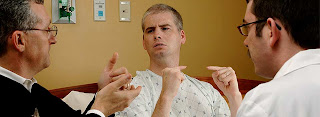Believe it or not, sign language is not for deaf people, members of the military, or the occasional interpreter. Recently, sign language has been delving itself into the heart of media and hollywood. No, not because certain actors or actresses are deaf, but because, sadly, the population of deaf people in this country is rapidly increasing. Surprisingly not because of louder rap music or crazier parties, but because of heredity and genes. Just in the past year, I have come across so many different things in the media that include sign language, without even looking for them. I do not scour the internet on a daily basis, so that means the sign language had to be very prominent in media sources like youtube, television, etc. Here is me ranting about ASL and the media. Hopefully you find it as interesting as I do.
Two things I have found, one is a music video and one is a TV show, revolve completely around sign language, and all if not any of the members are actually deaf. The music video is for the song Give Me Your Hand by The Ready Set. When hearing this song on the radio, I just viewed the song as another fairly good pop punk song that will be overplayed on the radio and in a few years everyone will forget that it even exists. But when I say the music video I thought otherwise. This music video is completely different than any proffesional one I have seen before. It opened with a pretty blonde woman just standing against a plain background swaying with the instrumental introduction to the song, typical, maybe even somewhat boring for a normal music video. Then, when the lyrics start, the woman begins to sign the lyrics with the rythm of the music. I can say, I have developed the opinion that the most of the media is shallow and unaware of current issues in the world, but this music video geniunely opened my eyes. I may actually have faith in new music videos for a few weeks until another Harlem Shake video becomes viral.
If my jaw wasn't all the way on the floor by then, it was in the next minute of the video. Clips were then shown of the woman going out on the streets of what I assume is LA or southern California, and teaching random people how to sign the chorus of the song. Now this may just be a continuation of the trend of public embarassment that the media thinks is hilarious, but I am trying to be optimistic, so I believe that it really made these people more aware that sign language is emerging and it is important. Hopefully ASL can become one of those new, insane trends like Gangnam Style, Call Me Maybe, the Harlem Shake (Why?), or dressing up like a mix of Lana Del Ray and Lady Gaga, so the word can actually spread about the importance of this language. Deaf people should be able to communicate with everyone else, it's not fair that they should only be able to speak to the select few people that know sign language.
Here is the music video:
If you thought the music video shocked and amazed me, you haven't seen anything yet. So, there is a television show called Switched at Birth which plays on the major network, ABC Family, and has millions of viewers tuning in for every single episode. So far they have had 2 seasons and, the series' debut was the highest-rated show debut for ABC Family to date. Now, you think this may just be a normal teen drama about vampires, werewolves, pregnancy, or "A", but it is entirely different. According to ABC Family, it is "the first mainstream television series to have multiple deaf and hard-of-hearing series regulars and scenes shot entirely in ASL." Not only does this show include heavy amounts of ASL, but they have multiple deaf and hard-of-hearing SERIES REGULARS. It blows my mind that it has taken television networks this long to realize how important this is and stop discriminating against deaf people. If people of every age, ethnicity, gender, and sexual orientation can dominate the media, deaf and hard-of-hearing people should be able to also.
To give a basic overview, the show, if you haven't heard about it or seen it, centers around these two girls who were accidently switched in the hospital as newborns. One of the girls grows up in a poor family, without a father, and becomes deaf. The other grows up in a rich family, with her hearing, and feels like she does not belong. They finally realize they were switched, and the soap opera/ teen drama continues, only not like a normal soap opera or teen drama. Being that the one girl is deaf, her mom signs, and that she goes to a deaf school, the show was bound to show ASL. But unlike normal TV show writers who would avoid certain situations like this, they attacked it head on. Switched at Birth has several, just ASL scenes, and although some people think the silence is akward, I could not love those scenes any more.
Here is a scene in an episode:










